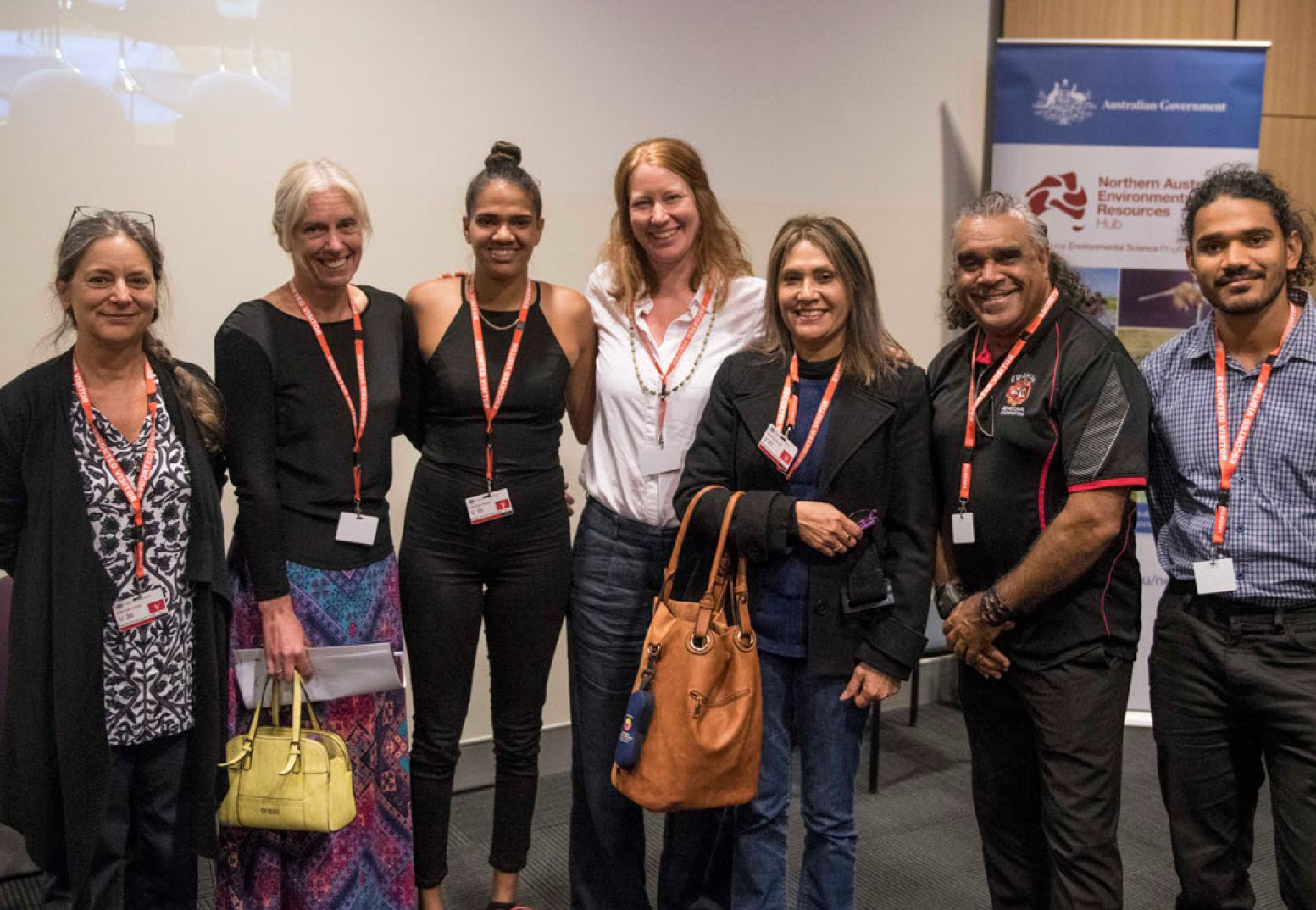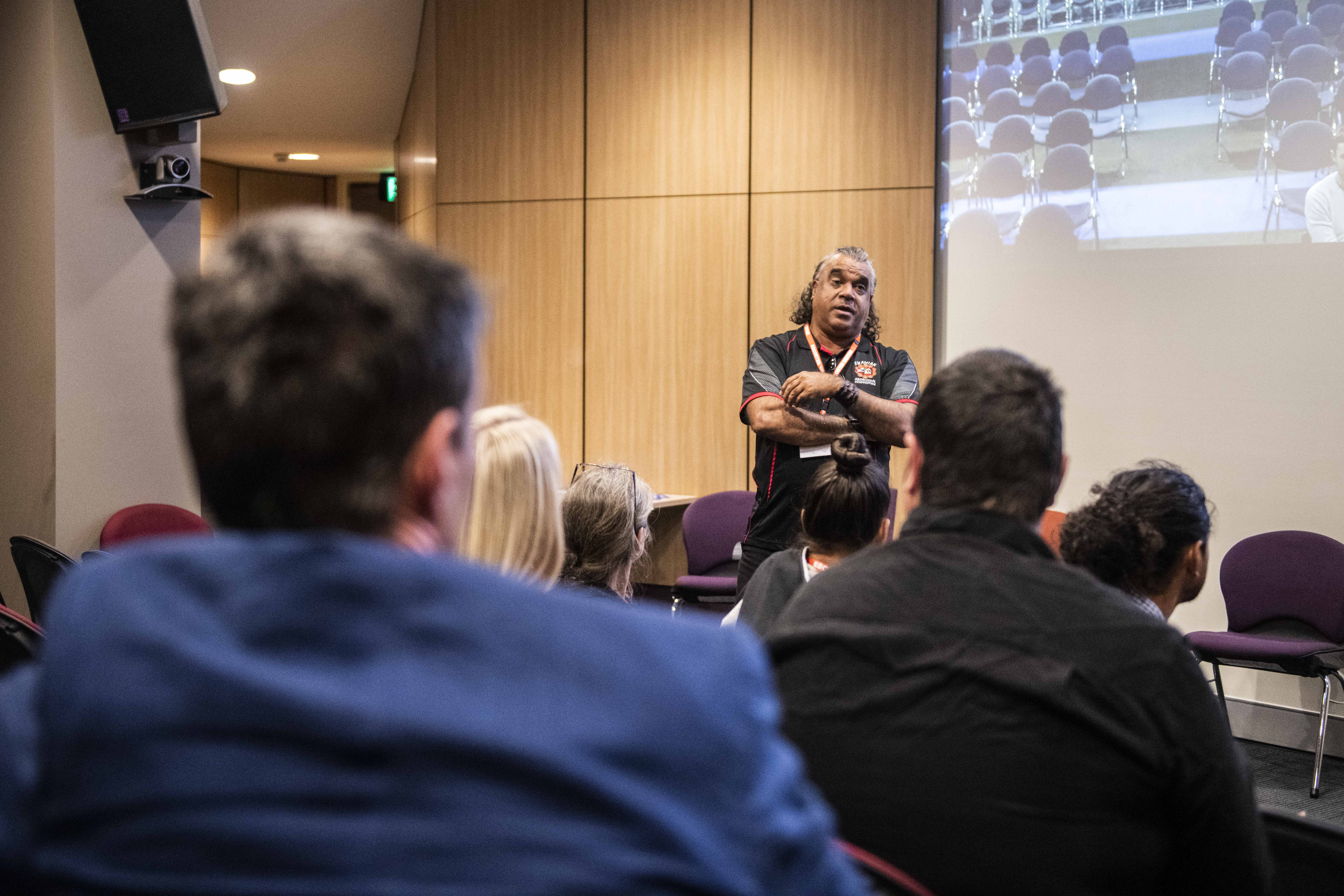This research has demonstrated that Indigenous land and sea management programs (ILSMPs) deliver socioeconomic and wellbeing outcomes in addition to their extensive environmental outcomes.
Moreover, just being involved in this research has had many positive impacts for communities in WA’s Fitzroy River valley and north Queensland, including positive impacts for land management.

Natalie Stoeckl, Diane Jarvis, Celia Boxer, Jane Addison, Sharon Prior, David Hudson and Emile Boxer – researchers, co-researchers and collaborators – at the Department of Agriculture, Water and the Environment in Canberra during 2018 Reconciliation Week. Photo: NESP Northern Hub.
It was deadly.
– Celia Boxer, Walmajarri (WA) Traditional Owner and co-researcher, describing her experience of being involved this project
Indigenous land and sea management programs (ILSMPs) – which include Indigenous ranger, Caring for Country and Indigenous Protected Area programs – have well-documented environmental and ecological benefits. This research showed that in addition, these programs deliver co-benefits such as socio-economic and wellbeing benefits, which are less well known and more difficult to quantify.
But for Indigenous people from WA’s Fitzroy River valley and north Queensland, simply participating in the research – for example, through undertaking interviews, being interviewed and follow-on conversations catalysed by interviews – has also had significant positive impacts.
The project employed Traditional Owners as co-researchers – Celia and Emile Boxer in the Kimberley, and David Hudson and Sharon Prior in north Queensland – and more specifically as ‘cultural brokers’ who undertook interview survey work with community members.
At an individual level this had positive benefits for those involved, including learning new skills, personal growth, re-connection with extended family, and knowledge about Country:
Doing this [research] … I was meeting my family that I hadn’t seen in ages and getting introduced to some of the elders that I probably hadn’t seen in 10 years. I felt good doing it.
– Celia Boxer
[It] has been quite empowering and quite important for myself and my development just as a person. To go back [to remote communities] as an adult, I could see it from a different perspective.
– Emile Boxer, Walmajarri Traditional Owner and co-researcher
“[This project has] been of great importance to us. Because it opened our eyes up and made us open our views on what we want to do on Country.” – Dr David Hudson

Dr David Hudson presents to staff from the Department of Agriculture, Water and the Environment, photo NESP Northern Hub.
The research interviews have also helped Ewamian Traditional Owners in Queensland plan for the future development of the newly acquired Talaroo Station near Georgetown, by choosing options that maintain cultural and ecological values, and maximise the benefits and wellbeing for all involved.
[This project has] been of great importance to us. Because it opened our eyes up and made us open our views on what we want to do on Country. The project team interviewed a lot of our Ewamian people, and they’ve all expressed they want to keep it [development] as cultural as possible.
– Dr David Hudson, Ewamian Traditional Owner and Chairperson of Ewamian Aboriginal Corporation
We found out a lot of information from the Ewamian people about what was important to them and what their priorities were and what their aspirations were for their traditional Country … that was one of the benefits of doing this project, finding out what was on everybody’s minds and what they wanted for the future.
– Sharon Prior, Ewamian Traditional Owner
Interviews also showed how land management programs are having an impact beyond their direct environmental impacts:
We asked… how was it five years ago and how is it now? [There was a] huge difference. The land management program[s], I think they are doing such a good job. The elders that we spoke to, they were really proud that they had young people doing it. Going to the schools and taking some of the kids out onto Country and showing them what bush tucker is … It was just really awesome.
– Celia Boxer
The research has given a voice to community members and deepened understandings on all sides about what’s important to communities.
The response from a lot of the people there [in communities] was … that they felt like their opinions about these sorts of things, including well-being, were valued … that was probably one of the most beneficial things that I feel like they came away with from the research.
– Emile Boxer
Travelling to co-present research results to staff at the Department of the Environment and Energy and Department of the Prime Minister and Cabinet also had impacts.
… I got a better understanding of how people’s opinions can be incorporated into policy.
– Emile Boxer
[Meeting policy-makers in Canberra] is very important to us … To come down here and actually speak to the main officers and the staff, it’s been of great relevance and it’s important.
– Dr David Hudson
More impacts are expected as project findings are promoted over the next few months.
 Funding for ILSMPs generates improvements in many different forms of ‘capital’. These flow through to Indigenous households and businesses, stimulating Indigenous economies and contributing to prosperous Indigenous communities and multiple other benefits. A PDF of this diagram is available here.
Funding for ILSMPs generates improvements in many different forms of ‘capital’. These flow through to Indigenous households and businesses, stimulating Indigenous economies and contributing to prosperous Indigenous communities and multiple other benefits. A PDF of this diagram is available here.
Please check out this video to hear direct from Celia, Emile, Sharon and David about the benefits of being involved in the research!
Research outputs
Journal articles
Factsheets
Policy notes
Videos & presentations
Project webpage
Attributions

![]()
In Western Australia, this project partnered with Bunuba, Gooniyandi, Walmajarri and Nyikina-Mangala Traditional Owners. In Queensland, this project partnered with Ewamian Traditional Owners.